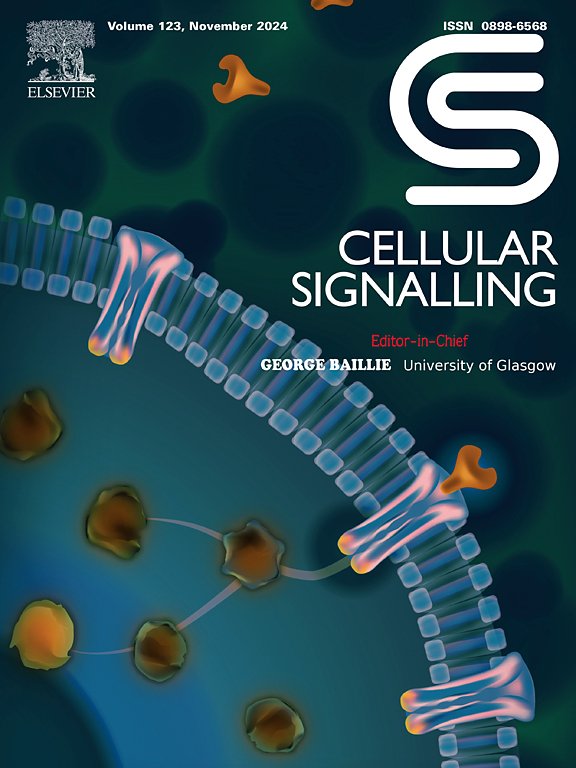用拉runculin A破坏肌动蛋白细胞骨架可控制atp诱导的nadph氧化酶活性和中性粒细胞gαq偶联受体募集g蛋白。
IF 3.7
2区 生物学
Q2 CELL BIOLOGY
引用次数: 0
摘要
中性粒细胞中表达的原型G蛋白偶联受体(GPCR) FPR1的信号传导是由含有Gαi亚基的G蛋白激活启动的。FPR1的激活导致胞浆中游离钙离子([Ca2+]i)浓度的增加,并激活NADPH氧化酶。ATP受体P2Y2产生的信号由含有G蛋白的Gαq转导。ATP诱导的中性粒细胞反应包括[Ca2+]i的短暂升高,但没有任何NADPH氧化酶的激活。然而,ATP可以通过依赖于P2Y2R和变构调节的游离脂肪酸受体FFA2R的受体转激活机制激活这种氧化酶。通过g αq偶联ATP受体激活FFA2R的信号从质膜的细胞质侧起作用。此外,在肌动蛋白细胞骨架被破坏的中性粒细胞中,ATP(以及血小板活化因子;由g αq偶联的PAFR识别)有效激活NADPH氧化酶。在高浓度的肌动蛋白细胞骨架破坏药物latrunculin A中,Gαq抑制和Gαi抑制剂百日咳毒素部分降低了激活。随着拉曲库林A浓度的降低,Gαq抑制剂和百日咳毒素对atp诱导的NADPH氧化酶活性的影响分别增强和减弱。综上所述,我们发现中性粒细胞肌动蛋白细胞骨架是调节机制的一部分,它决定了NADPH氧化酶的激活和G蛋白募集谱的下游,两个Gαq偶联的gpcr在初级中性粒细胞中表达。本文章由计算机程序翻译,如有差异,请以英文原文为准。

Disruption of the actin cytoskeleton with latrunculin A controls ATP-induced nadph oxidase activity and the recruitment of G proteins by neutrophil Gαq-coupled receptors
Signaling by FPR1, the prototype G protein-coupled receptor (GPCR) expressed in neutrophils, is initiated by an activation of a G protein containing a Gαi subunit. FPR1 activation results in an increase in the cytosolic concentration of free calcium ions ([Ca2+]i), and an activation of the NADPH oxidase. Signals generated by the ATP receptor P2Y2 are transduced by a Gαq containing G protein. The neutrophil response induced by ATP includes a transient rise in [Ca2+]i, but not any activation of the NADPH oxidase. ATP can, however, activate this oxidase through a receptor transactivation mechanism dependent both on P2Y2R and on the allosterically modulated free fatty acid receptor FFA2R. The signals whereby FFA2R is activated by the Gαq-coupled ATP receptor operate from the cytosolic side of the plasma membrane. Furthermore, in neutrophils with a disrupted actin cytoskeleton, ATP (as well as platelet activating factor; recognized by the Gαq-coupled PAFR) potently activates the NADPH oxidase. At high concentrations of the actin cytoskeleton disrupting drug latrunculin A the activation was partly reduced by Gαq inhibition as well as by the Gαi inhibitor pertussis toxin. The effects on the ATP-induced NADPH oxidase activity, of the Gαq inhibitor and pertussis toxin were more and less pronounced, respectively, when the concentration of latrunculin A was reduced. Taken together, we show that the neutrophil actin cytoskeleton is part of the regulatory machinery that determines the activation of the NADPH oxidase and the G protein recruitment profile downstream of activated of two Gαq-coupled GPCRs expressed in primary neutrophils.
求助全文
通过发布文献求助,成功后即可免费获取论文全文。
去求助
来源期刊

Cellular signalling
生物-细胞生物学
CiteScore
8.40
自引率
0.00%
发文量
250
审稿时长
27 days
期刊介绍:
Cellular Signalling publishes original research describing fundamental and clinical findings on the mechanisms, actions and structural components of cellular signalling systems in vitro and in vivo.
Cellular Signalling aims at full length research papers defining signalling systems ranging from microorganisms to cells, tissues and higher organisms.
 求助内容:
求助内容: 应助结果提醒方式:
应助结果提醒方式:


